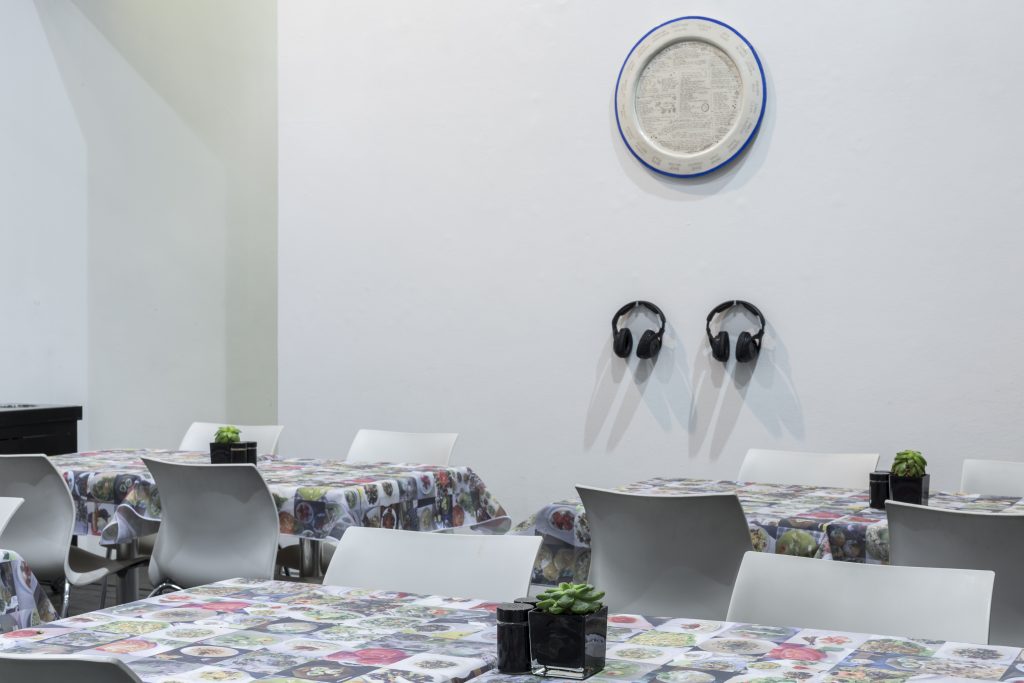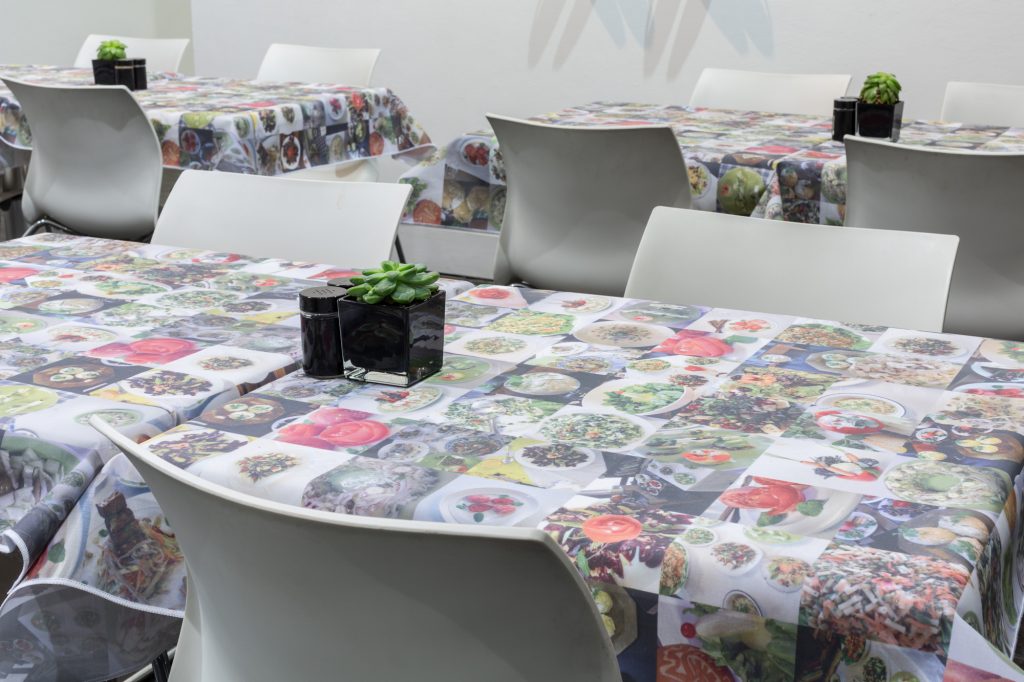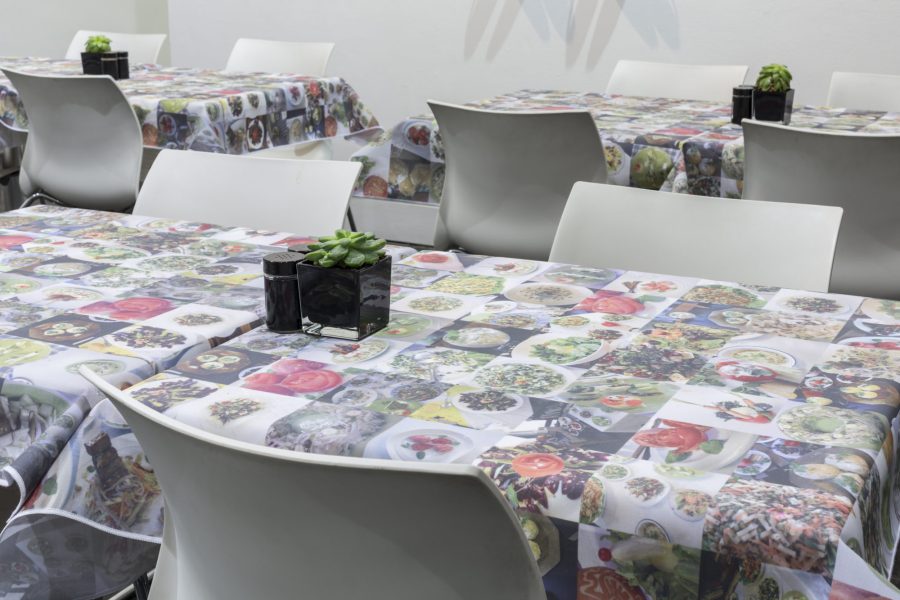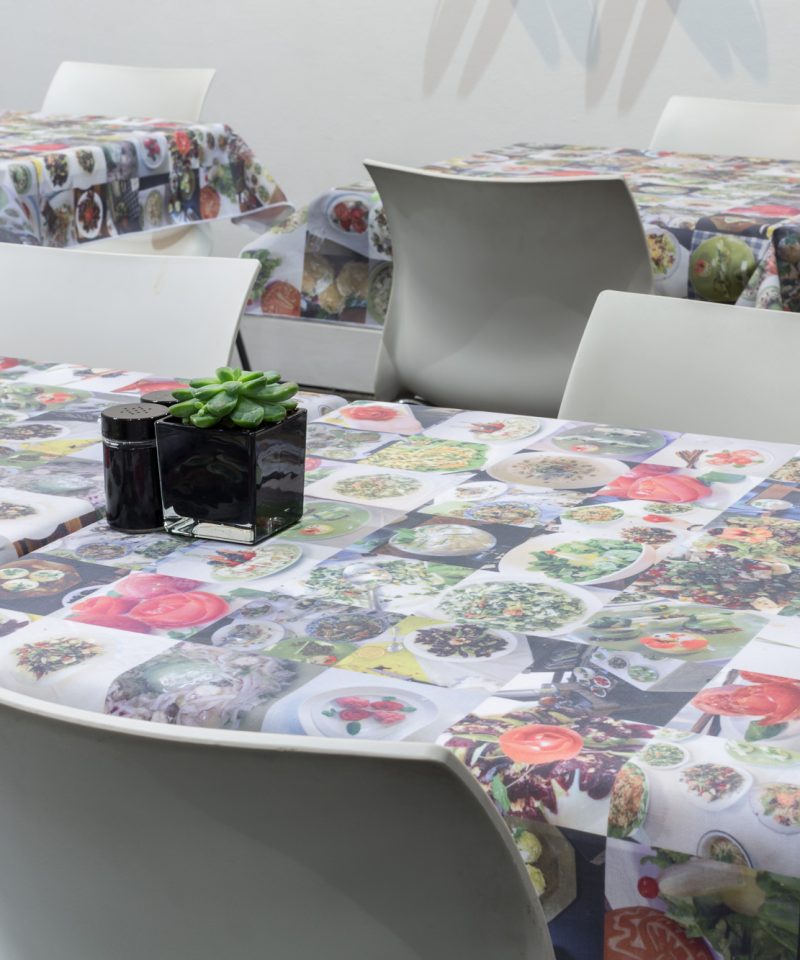
I’ve taken myself to a café to write my final blog post as Jerwood Writer in Residence. To write in cafés may be ‘such a cliché that it needs no explanation’ but I’ll put it pragmatically: the distractions of domesticity can be avoided, exchanged for others of a focusing kind in a café where you can pay someone else to serve you and clear up when you’re done. Had I stayed at home I could have conjured the cafe atmosphere with ‘Coffitivity’ but I’d have been surrounded by a heap of dirty laundry, an unmade bed, the unpredictable sounds and movements of six housemates, the possibility of so many more chores. There have been many days when I’ve preferred, told myself it was essential to do a mind clearing, guilt relieving or simply necessary number of domestic tasks before beginning to write. The need to fulfil the compulsion to write/make/create, and before that the need to be paid, is always in competition with other time consuming and unremunerated forms of reproductive labour.
In her 1969 Maintenance Art Manifesto, Mierle Laderman Ukeles categorised human labour as falling into ‘Two basic systems: Development and Maintenance’:
Development: pure individual creation; the new; change; progress; advance; excitement; flight or fleeing.
[…]
Maintenance is a drag; it takes all the fucking time (lit.)
The mind boggles and chafes at the boredom.
The culture confers lousy status on maintenance jobs =
minimum wages, housewives = no pay.
clean you desk, wash the dishes, clean the floor,
wash your clothes, wash your toes, change the baby’s
diaper, finish the report, correct the typos, mend the
fence, keep the customer happy, throw out the stinking
garbage […]
Ukeles emphasised the unequal division of labour along lines of gender and class – the excitements of development all too often enjoyed by men for example, while maintenance tasks overwhelmingly fall to women. I look up from my laptop and framed by the café window there’s the 236 bus, halted at traffic lights and carrying a pretty teenager applying lipstick, maintaining her appearance in the reflection of her iPhone.
Ukeles’ maintenance category included cooking, also too often gendered female, especially when taking place in the home as opposed to in the professional restaurant kitchen:
I am an artist. I am a woman. I am a wife. I am a mother. (Random order). I do a hell of a lot of washing, cleaning, cooking, renewing, supporting, preserving, etc.
The preparation of food was not among the tasks that Ukeles would go on to perform in an art context (In 1973 the Wadsworth Athenaeum museum hosted Maintenance Art Performances.). In contrast, documentation of food preparation (if not cooking itself, perhaps to avoid treading on old relational aesthetics ground) is shown in Susannah Worth’s How to Do Things with Salad, exhibited in the Project Space – an art space that spills over into the functional space of a café. The work is partly functional too, consisting of tablecloths covering all the usual tables, a plate hung on the wall, and of audio – an essay read aloud that layers recipes and anecdotes with observations regarding the visual circulation of food via social media, the rituals and traditions associated with the preparation of food, a form of labour that is frequently aestheticized, and often more pleasurable if collectivised.
I can imagine the audio providing the kind of low-level noise that would help a solitary worker focus, while also perhaps inspiring that worker to consider collaborative work, or tempt them through descriptions of flavours and textures into taking a proper break to enjoy their food. I wonder if when, on the two Mondays prior to writing this blog post, I met Alice May Williams and then Karen Kramer at lunchtime to go through the final stages of preparation for the radio shows we recorded, we were in some sense satisfying an ideal of working together proposed by Susannah Worth’s work. We may not have made our meals but we did enjoy eating them, Alice choosing a pasta dish that seemed so fitting because her film Dream City – More, Better, Sooner troubles the logic of (property) development that prioritises speed and speculative futures while pasta is associated with taking things slow. Dream City also values history, the archive and learning from previous generations, and pasta was once the target of Futurist hatred precisely because it was deemed to represent the past. As Marinetti wrote in his 1930 Manifesto of Futurist Cooking:
Pastasciutta, 40% less nutritious than meat, fish or pulses, ties today’s Italians with its tangled threads to Penelope’s slow looms and to somnolent old sailing ships in search of wind. Why let its massive heaviness interfere with the immense network of short long waves which Italian genius has thrown across oceans and continents? Why let it block the path of those landscapes of colour form sound which circumnavigate the world thanks to radio and television? The defenders of pasta are shackled by its ball and chain like convicted lifers or carry its ruins in their stomachs like archaeologists.
How to Do Things with Salad may have satisfied Marinetti through its focus on the light food type that salad constitutes but its decorative, friendly means of communicating itself would surely have been anathema to him and the Futurist preference for dynamism and smooth straight lines. Worth’s tablecloths represent the distinctly un-Futurist efforts of a workshop held by Worth in November at Open School East: participants were invited to follow many different salad recipes and then photograph the results, which are then represented communally, documented mosaic-fashion on Worth’s tablecloths, perhaps against the logic of Instagram (Worth comments on the Instagram-native practice of hashtagging one’s food photos) where a single user’s images – often of food – are fed one by one to their followers.
The ceramic plate under which the audio plays through headphones is also a collective document, featuring the names of all the Open School East salad makers and the ingredients that they used. It struck me as a way of making labour visible, much in the way that Ukeles insisted on in her Maintenance Art Manifesto and subsequent performances, while the plate as medium reminded me of Judy Chicago’s Dinner Party of 1979.
Before quitting Facebook just over a year ago, Dinner Party was among the works suggested when I put the following question to the ‘hive mind’: ‘Examples of artworks involving food and/or eating? Can think of a good few but want to consider many.’ I saved the results of this lazy, outsourced form of research, and in the spirit of Susannah Worth’s work (which acknowledges that ‘the recipe is a form of writing that has been adopted and adapted within literature and visual art, and especially in performance art, where food has proved a rich source of material…’), sign off by sharing them with some of my ideas added in the mix, in chronological order as a partial recipe for anyone wanting to further explore the role of food in art since the 1920s.
Oswald de Andrade, Manifesto Antropófago (Cannibal Manifesto), 1928
https://events.ccc.de/congress/2009/Fahrplan/attachments/1386_cannibalmanifesto1928.pdf
Salvador Dali, Autumnal Cannibalism, 1936
www.tate.org.uk/art/artworks/dali-autumnal-cannibalism-t01978
Piero Manzoni, Achrome, 1961
www.pieromanzoni.org/EN/Gallery_en/pop226.htm
Carolee Schneeman, Meat Joy, 1964
www.caroleeschneemann.com/meatjoy.html
Dieter Roth, Literature Sausage (Literaturwurst). 1969
www.moma.org/interactives/exhibitions/2013/dieter_roth/works/literature-sausage/
Jørgen Leth, 66 Scenes from America, 1982 (in which Andy Warhol eats a hamburger)
www.youtube.com/watch?v=fLQcmTJCSc8
Claes Oldenburg, Floor Burger, 1962
www.moma.org/explore/multimedia/audios/357/4839
Caroline Goodden, Gordon Matta-Clark, Tina Girouard, Suzanne Harris, Rachel Lew, FOOD, 1971
www.cca.qc.ca/en/study-centre/1838-the-story-of-food
John Baldessari, Choosing: Green Beans, 1972
http://www.macba.cat/en/a03714
KwieKulik, ‘Activities with Dobromierz,’ 1972-74
www.zak-branicka.com/files/pub_file_28_en_d41d8cd98f00b204e9800998ecf8427e.pdf
Stuart Brisley, 10 Days, 1973
www.stuartbrisley.com/pages/27/70s/Works/10_Days/page:18
Jean Dupuy, Soup & Tart, 1974
www.thekitchen.org/event/jean-dupuy-soup-and-tart
Natalia LL, ‘Consumer Art,’ 1975
http://artmuseum.pl/en/filmoteka/praca/ll-natalia-sztuka-konsumpcyjna
CADA, Para no morir de hambre en el arte (Not to die of hunger in art) 1979
www.museoreinasofia.es/en/collection/artwork/no-morir-hambre-arte-not-die-hunger-art
Felix Gonzalez Torres, “Untitled” (Public Opinion), 1991
www.guggenheim.org/artwork/1512
Jan Svankmajer, Food, 1992
https://vimeo.com/50746661?
Rirkrit Tiravanija, ‘Untitled (Free)’, 1992
www.moma.org/explore/inside_out/2012/02/03/rirkrit-tiravanija-cooking-up-an-art-experience
Angela Bulloch, Liam Gillick. An Old Song and a New Drink, 1993-2014
www.ecoledumagasin.com/session23/en/an-old-song-and-a-new-drink/
Ellie Harrison, Eat 22, 2002
www.eat22.com/
Sophie Calle, ‘The Chromatic Diet,’ 1998
https://crowincrowndotcom.wordpress.com/2011/02/23/the-chromatic-diet-sophie-calle/
Rainer Ganahl, ‘Credit Crunch Meals,’ 2008 –
www.ganahl.info/creditcrunch.html
Pil and Galia Kollectiv, ‘Sci-Fi Banquet,’ 2008
www.kollectiv.co.uk/Event%20Horizon.html
Song Dong, Eat the City, 2010
www.odditycentral.com/news/chinese-artist-creates-edible-model-of-shanghai.html
William Alexander, ‘icecreamvanman,’ 2011 –
http://williamalexander.me.uk/page9.htm
‘Feast: Radical Hospitality in Contemporary Art,’ Smart Museum of Art, University of Chicago, 2012, including art, documentary materials, and public projects by Marina Abramović and Ulay, Sonja Alhäuser, Mary Ellen Carroll, Fallen Fruit, Theaster Gates, Felix Gonzalez-Torres, InCUBATE, The Italian Futurists, Mella Jaarsma, Alison Knowles, Suzanne Lacy, Lee Mingwei, Laura Letinsky, Tom Marioni, Gordon Matta-Clark, Mildred’s Lane, Julio César Morales and Max La Rivière-Hedrick, motiroti, National Bitter Melon Council, Ana Prvacki, Sudsiri Pui-Ock, Michael Rakowitz, Ayman Ramadan, Red76, David Robbins, Allen Ruppersberg, Bonnie Sherk, Barbara T. Smith, Daniel Spoerri, and Rirkrit Tiravanija.
http://smartmuseum.uchicago.edu/exhibitions/feast/
Peles Empire, ‘ART SOUP 1,’ 2012
www.templebargallery.com/events/event/art-soup-1
Bedwyr Williams, ‘Curator. Cadaver. Cake,’ 2012
www.youtube.com/watch?v=Bu-ZENHW9Oc
Hannah Lees, ‘If I won’t burn, where will the light come from?’ 2013
www.v22collection.com/events/performance/friday-late-hannah-lees-if-i-wont-burn-where-will-/
Holly White, Memories of McDonalds, 2013
www.youtube.com/watch?v=zB_wf_tALfs
Maja Cule, Laughing Alone with Salad, 2013
http://disimages.com/photos/index/Story.id:92
Archie Franks, Scotch Eggs, 2014
https://britishschoolatrome.wordpress.com/tag/archie-franks/
United Brothers, Does This Soup Taste Ambivalent? 2014
www.theguardian.com/artanddesign/2014/sep/25/fukushima-vegetable-soup-frieze-london-art-fair
Paul McCarthy, ‘Chocolate Factory,’ 2014
www.monnaiedeparis.fr/en/exhibitions/paul-mccarthy
Oscar Murillo ‘A Mercantile Novel,’ 2014
www.mercantilenovel.com
‘M’m! M’m! Good!’ Group show with Luca Francesconi, Lisa Holzer, Maryam Jafri, David Jourdan, Sophie Lee, and Kate Sansom, Rowing Projects, 6 March – 18 April 2015
http://rowingprojects.com/projects/mm-mm-good
Sheila Callaghan, Women Laughing Alone, 2016
www.latimes.com/entertainment/arts/la-et-cm-women-laughing-alone-with-salad-review-20160314-story.html
Morehshin Allahyari and Daniel Rourke, The 3D Additivist Cookbook, forthcoming
http://additivism.org/cookbook



